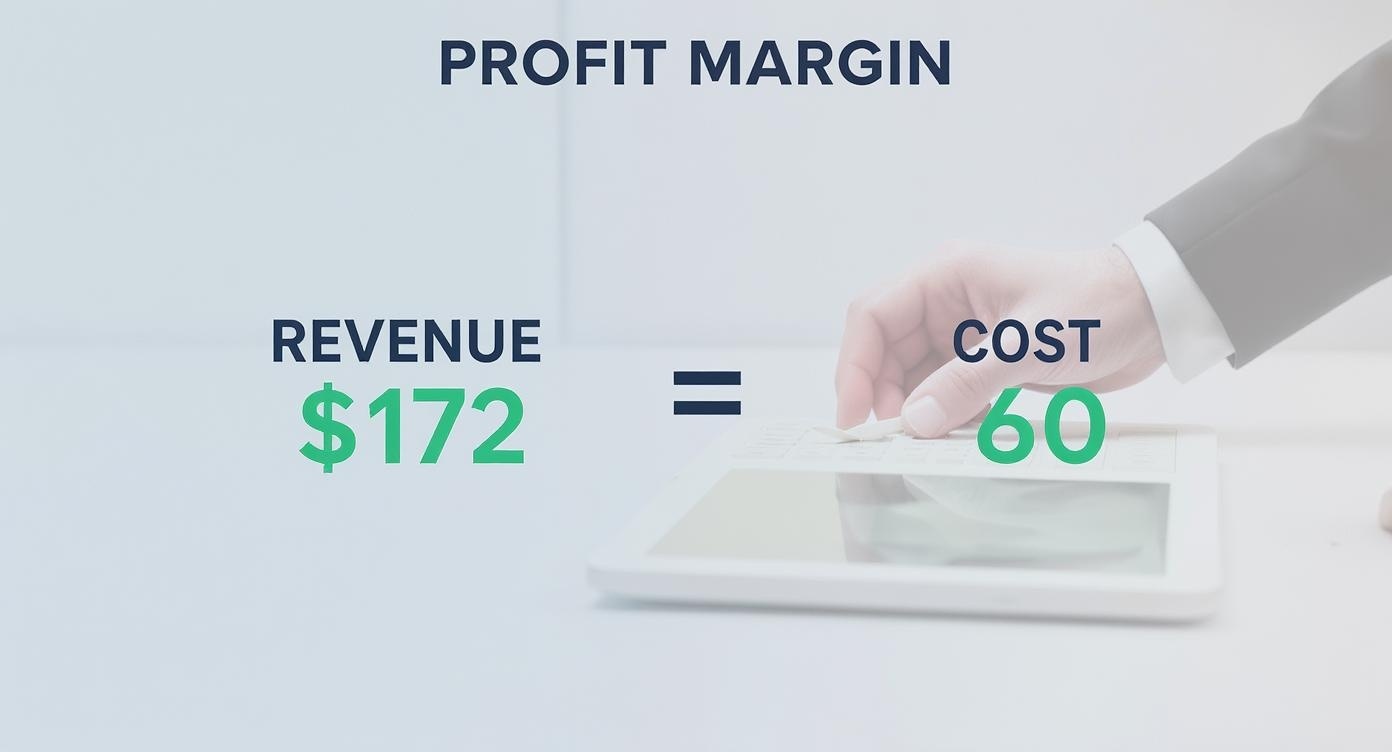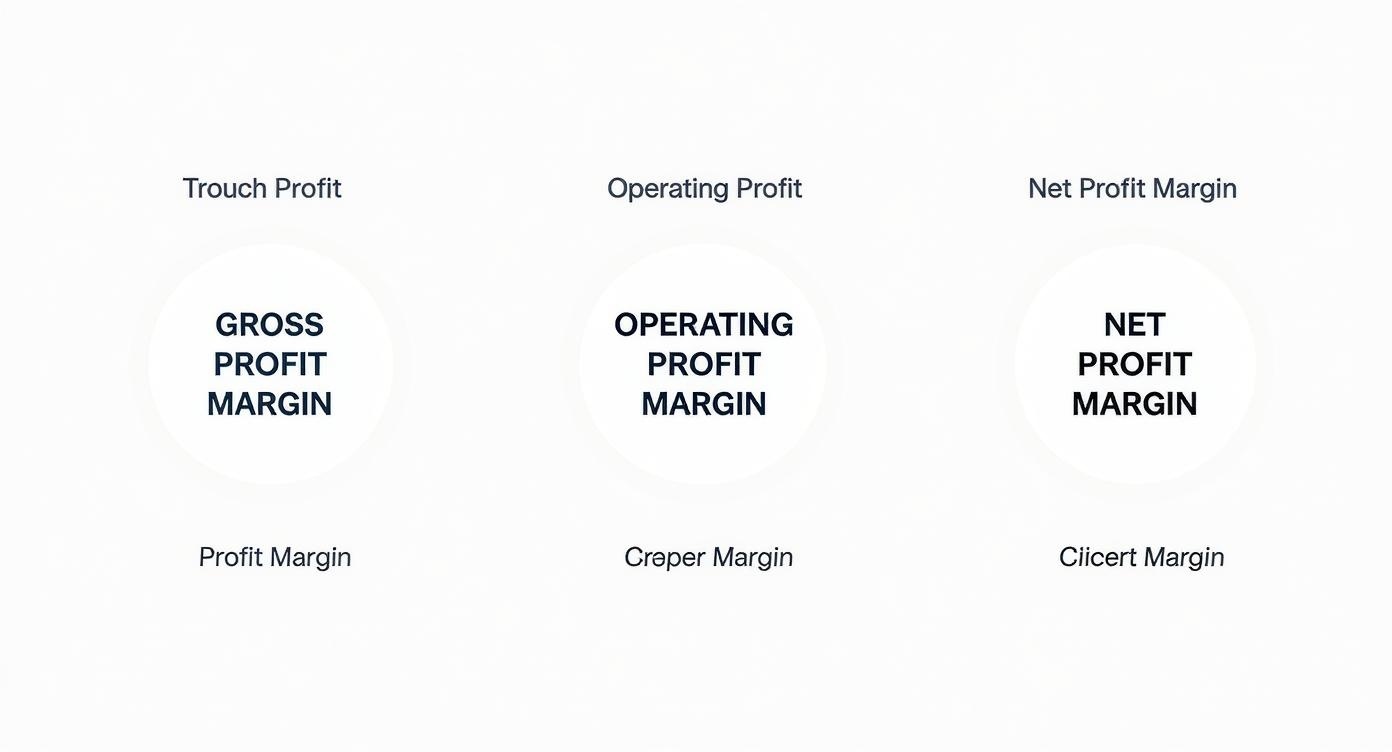
How to Calculate Profit Margin: Complete Guide with Examples
Master the essential skill of calculating profit margins with our comprehensive guide. Learn the formulas, understand the differences between gross, operating, and net profit margins, and discover practical applications for better business decision-making.
Table of Contents
What is Profit Margin?
Profit margin is a crucial financial metric that measures how much profit a company generates as a percentage of its revenue. It tells you how efficiently a business converts sales into profits, making it essential for investors, business owners, and financial analysts to understand a company's financial health and operational efficiency.

Understanding profit margins helps you:
- Evaluate business performance and efficiency
- Compare companies within the same industry
- Make informed investment decisions
- Identify areas for cost optimization
- Set appropriate pricing strategies
- Track financial progress over time
Types of Profit Margins

There are three main types of profit margins, each providing different insights into a company's financial performance:
| Profit Margin Type | What It Measures | Key Focus | Typical Range |
|---|---|---|---|
| Gross Profit Margin | Revenue after cost of goods sold | Production efficiency | 20-50% |
| Operating Profit Margin | Revenue after operating expenses | Operational efficiency | 10-30% |
| Net Profit Margin | Revenue after all expenses | Overall profitability | 5-20% |
Gross Profit Margin Calculation
Gross profit margin measures the percentage of revenue remaining after deducting the cost of goods sold (COGS). It reflects how efficiently a company produces its goods or services.
Gross Profit Margin Formula
Gross Profit Margin = (Revenue - Cost of Goods Sold) ÷ Revenue × 100
Example: Gross Profit Margin Calculation
Company ABC:
- Revenue: $500,000
- Cost of Goods Sold: $300,000
Calculation:
Gross Profit = $500,000 - $300,000 = $200,000
Gross Profit Margin = ($200,000 ÷ $500,000) × 100 = 40%
What this means: For every dollar of revenue, Company ABC retains 40 cents after covering production costs. This indicates good control over manufacturing or procurement costs.
Operating Profit Margin Calculation
Operating profit margin shows the percentage of revenue remaining after deducting both cost of goods sold and operating expenses (like rent, salaries, marketing, and administrative costs).
Operating Profit Margin Formula
Operating Profit Margin = Operating Income ÷ Revenue × 100
Where Operating Income = Revenue - COGS - Operating Expenses
Example: Operating Profit Margin Calculation
Company ABC (continued):
- Revenue: $500,000
- Cost of Goods Sold: $300,000
- Operating Expenses: $120,000
Calculation:
Operating Income = $500,000 - $300,000 - $120,000 = $80,000
Operating Profit Margin = ($80,000 ÷ $500,000) × 100 = 16%
What this means: Company ABC maintains 16% of revenue as operating profit, demonstrating efficient management of both production and operational costs.
Net Profit Margin Calculation
Net profit margin represents the percentage of revenue that remains as profit after all expenses, including taxes, interest, and other non-operating expenses.
Net Profit Margin Formula
Net Profit Margin = Net Income ÷ Revenue × 100
Where Net Income = Revenue - All Expenses (COGS + Operating + Interest + Taxes)
Example: Net Profit Margin Calculation
Company ABC (continued):
- Operating Income: $80,000
- Interest Expense: $10,000
- Taxes: $20,000
Calculation:
Net Income = $80,000 - $10,000 - $20,000 = $50,000
Net Profit Margin = ($50,000 ÷ $500,000) × 100 = 10%
What this means: Company ABC's bottom line shows they keep 10 cents of every dollar in revenue as net profit, indicating solid overall financial performance.
Real-World Examples by Industry
Profit margins vary significantly across industries due to different business models, competition levels, and cost structures:
| Industry | Gross Margin | Operating Margin | Net Margin | Key Factors |
|---|---|---|---|---|
| Software/Technology | 70-90% | 15-30% | 15-25% | Low production costs, high R&D |
| Retail | 20-40% | 2-8% | 2-6% | High competition, inventory costs |
| Manufacturing | 15-25% | 5-10% | 3-8% | Material costs, equipment expenses |
| Food Service | 60-70% | 3-9% | 2-6% | High labor costs, rent |
| Healthcare | 40-60% | 8-18% | 5-15% | Regulatory compliance, specialized equipment |
Case Study: E-commerce vs. Traditional Retail
Online Retailer:
- Lower overhead costs (no physical stores)
- Higher gross margins (35-45%)
- Investment in technology and logistics
Traditional Retailer:
- Store rent, utilities, staff costs
- Lower gross margins (25-35%)
- Higher operating expenses
Industry Benchmarks and What Constitutes Good Profit Margins
Understanding industry benchmarks helps you evaluate whether a company's profit margins are competitive:
Good Profit Margin Guidelines:
- Gross Profit Margin: Above 20% is generally good, above 50% is excellent
- Operating Profit Margin: Above 10% is solid, above 20% is excellent
- Net Profit Margin: Above 5% is acceptable, above 10% is good, above 20% is exceptional
Factors Affecting Profit Margins
Positive Factors:
- Strong brand recognition and pricing power
- Efficient operations and cost management
- Economy of scale
- Low competition or market leadership
Negative Factors:
- High competition and price wars
- Rising material or labor costs
- Economic downturns
- Regulatory changes
How to Improve Profit Margins
Businesses can improve their profit margins through various strategies focused on increasing revenue or reducing costs:
Revenue Enhancement Strategies:
- Pricing Optimization: Increase prices based on value proposition
- Product Mix: Focus on higher-margin products or services
- Upselling and Cross-selling: Increase average transaction value
- Market Expansion: Enter new markets or customer segments
- Value-Added Services: Offer premium services with higher margins
Cost Reduction Strategies:
- Supply Chain Optimization: Negotiate better supplier terms
- Process Automation: Reduce labor costs through technology
- Inventory Management: Minimize carrying costs and waste
- Energy Efficiency: Reduce utility and operational costs
- Outsourcing: Transfer non-core activities to specialized providers
Margin Improvement Case Study
Manufacturing Company Example:
Before: 15% gross margin, 8% net margin
Actions Taken:
- Renegotiated supplier contracts (5% cost reduction)
- Implemented lean manufacturing (3% efficiency gain)
- Introduced premium product line (higher margins)
After: 22% gross margin, 12% net margin
Common Mistakes to Avoid
When calculating and analyzing profit margins, avoid these common pitfalls:
Critical Mistakes
- Inconsistent Time Periods: Comparing margins from different time periods without context
- Ignoring Seasonal Variations: Not accounting for seasonal business fluctuations
- Mixing Revenue Types: Including one-time gains in regular revenue calculations
- Incorrect Cost Classification: Misclassifying operating vs. non-operating expenses
- Industry Ignorance: Not considering industry-specific factors
Best Practices for Accurate Analysis:
- Use consistent accounting methods across periods
- Consider multiple quarters or years for trend analysis
- Compare with industry peers, not unrelated businesses
- Understand the company's business model and cost structure
- Factor in economic conditions and market cycles
- Use multiple margin types for comprehensive analysis
Tools and Calculators
Use these helpful tools and calculators to quickly compute profit margins and analyze business performance:
Profit Margin Calculator
Calculate gross, operating, and net profit margins instantly
Use Profit Margin Calculator →Break-Even Calculator
Determine break-even point and required sales volume
Use Break-Even Calculator →Share This Guide
Frequently Asked Questions
Profit margin is a financial ratio that measures the percentage of revenue that remains as profit after accounting for costs. It's calculated by dividing profit by revenue and multiplying by 100 to get a percentage. It indicates how efficiently a business converts sales into profits.
Gross profit margin only considers cost of goods sold, operating profit margin includes operating expenses like rent and salaries, and net profit margin accounts for all expenses including taxes and interest. Each provides different insights into business efficiency at various levels.
A good profit margin varies by industry. Generally, a net profit margin of 10-20% is considered healthy for most businesses, while gross profit margins typically range from 20-50%. Technology companies often have higher margins (15-25% net), while retail businesses typically have lower margins (2-6% net).
You can improve profit margins by increasing revenue (through pricing optimization, upselling, or expanding markets) or reducing costs (through supply chain optimization, automation, or process improvements). Focus on high-margin products and eliminate inefficiencies in operations.
No, comparing profit margins across different industries isn't meaningful because business models, cost structures, and competitive dynamics vary significantly. Instead, compare companies within the same industry or track your own margins over time to identify trends and improvements.
Calculate profit margins monthly for internal management and quarterly for external reporting. Regular monitoring helps identify trends, seasonal patterns, and the impact of business decisions. Annual calculations are useful for year-over-year comparisons and strategic planning.
Conclusion
Understanding how to calculate and analyze profit margins is essential for making informed business decisions, whether you're an entrepreneur, investor, or financial professional. By mastering gross, operating, and net profit margin calculations, you can evaluate business performance, identify improvement opportunities, and make strategic decisions that drive profitability.
Remember that profit margins should be analyzed in context—considering industry benchmarks, business cycles, and company-specific factors. Use the tools and calculators provided to streamline your calculations and focus on interpreting the results for actionable insights.
Ready to calculate profit margins? Bookmark this guide and explore our business calculator tools for quick and accurate calculations.